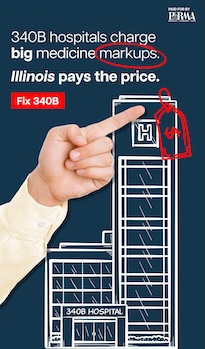Question of the day
Monday, Feb 1, 2016 - Posted by Rich Miller
* Tribune…
“President Obama has come out strongly in favor of both term limits and redistricting reform,” Rauner said [during his State of the State Address]. “I agree, and the people of Illinois agree. The only reasons not to do this are pure partisan politics, and a desire to cling to power.”
Obama said in his State of the Union address that the country should “end the practice of drawing our congressional districts so that politicians can pick their voters, and not the other way around.” He expressed broad support for the idea of term limits during a July trip to Africa, saying “nobody should be president for life.”While Republicans are hoping that Obama’s visit will inspire his allies to back Rauner on term limits and redistricting, Democrats said they have other priorities.
“It’s nice of him to return and grace us with his honorable self,” said Sen. Kim Lightford, D-Maywood. “But the better politics, better selves sounds like a peace offering in trying to help a real negotiation process or a real compromise to begin taking shape to get us past the budget impasse. And with all the challenges with police brutality in the state, it’s nice that he would come home for the ninth anniversary, but also in my hope, be the peace offering that we need to help us with many of the challenges that we’re facing.”
* CBS 2 hypes the visit…
Senate President John Cullerton recently wrote the president, saying now would be a good time for a visit.
“Well, he’s had some problems, himself, in Washington, so he’s certainly aware what the conflict is like,” Cullerton said. “He’s had to fight that. Hopefully he’ll have an effect on all of us.”
* The visit was a well-guarded secret, but somebody knew…
For the upcoming visit, the Springfield Police Department has had “several days” of notice, and the initial planning has begun, Deputy Chief Dan Mounce said.
The Secret Service is in charge of the detail, he said, and city police, and typically Illinois State Police and the Sangamon County Sheriff’s Office, assist them.
The level of security-related planning for an event of this magnitude depends on a number of factors, Mounce said.
“Rest assured that there is a significant amount of planning and manpower that’s needed for a visit by a president,” he said.
* And…
President Barack Obama has been to Springfield before and actually worked there as a state senator several years ago. Now, Gov. Bruce Rauner hopes when Obama returns next month, nine years after announcing his presidential candidacy, the two will have time for a beer together.
Springfield sources tell NBC 5 Rauner’s office has reached out to the White House to see if the president has time for a beer at Obed and Isaac’s when he visits Illinois Feb.10.
Obed and Isaac’s, steps from what’s known as the Lincoln neighborhood, is known for its craft beers – from the Backporch Farmhouse Ale to the Ditzy Blonde — and is quite popular among residents. […]
Details on how long Obama’s visit will be and what he will do during the trip weren’t immediately known. As for whether or not he and Rauner will toast a Backporch Farmhouse Ale, we’ll have to wait and see.
* The Question: Do you think President Obama should accept Gov. Rauner’s invitation? Take the poll and then explain your answer in comments, please.
panel management
Also, stick to the topic. I mean it.













